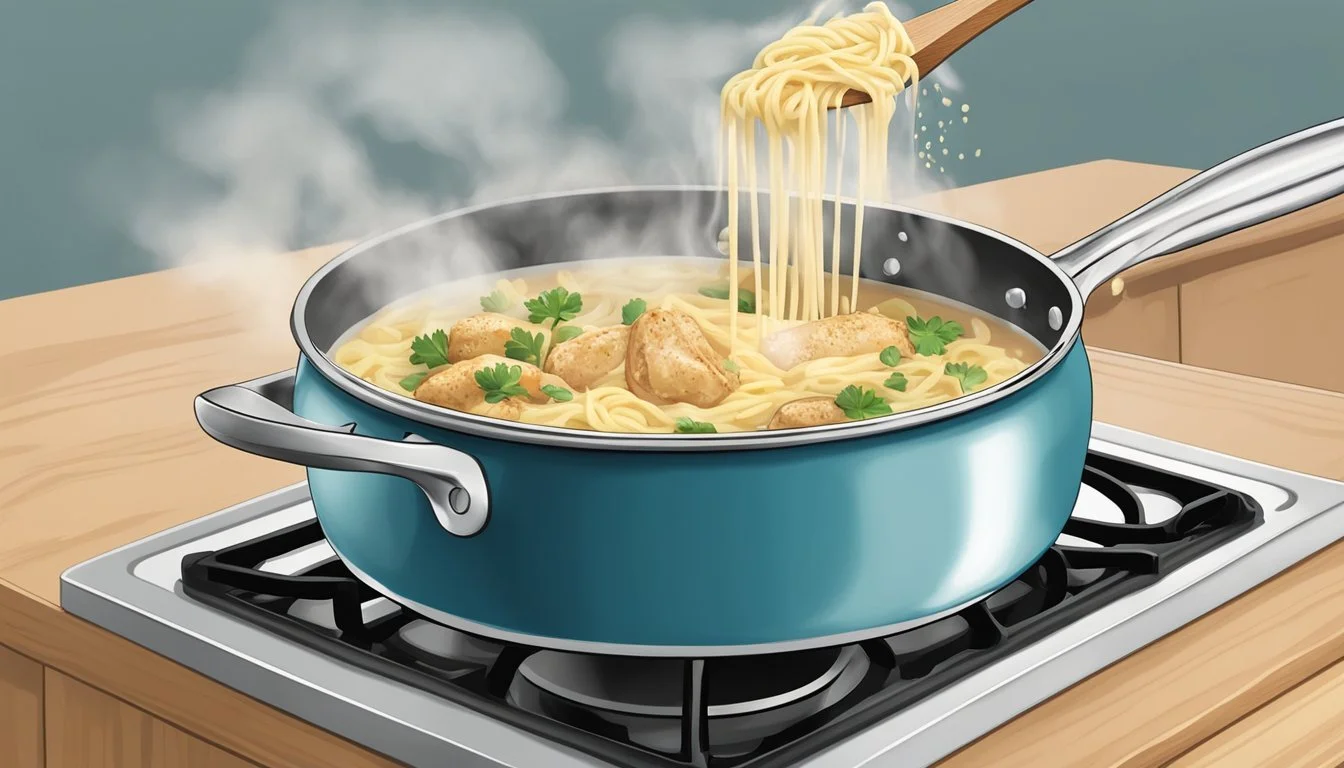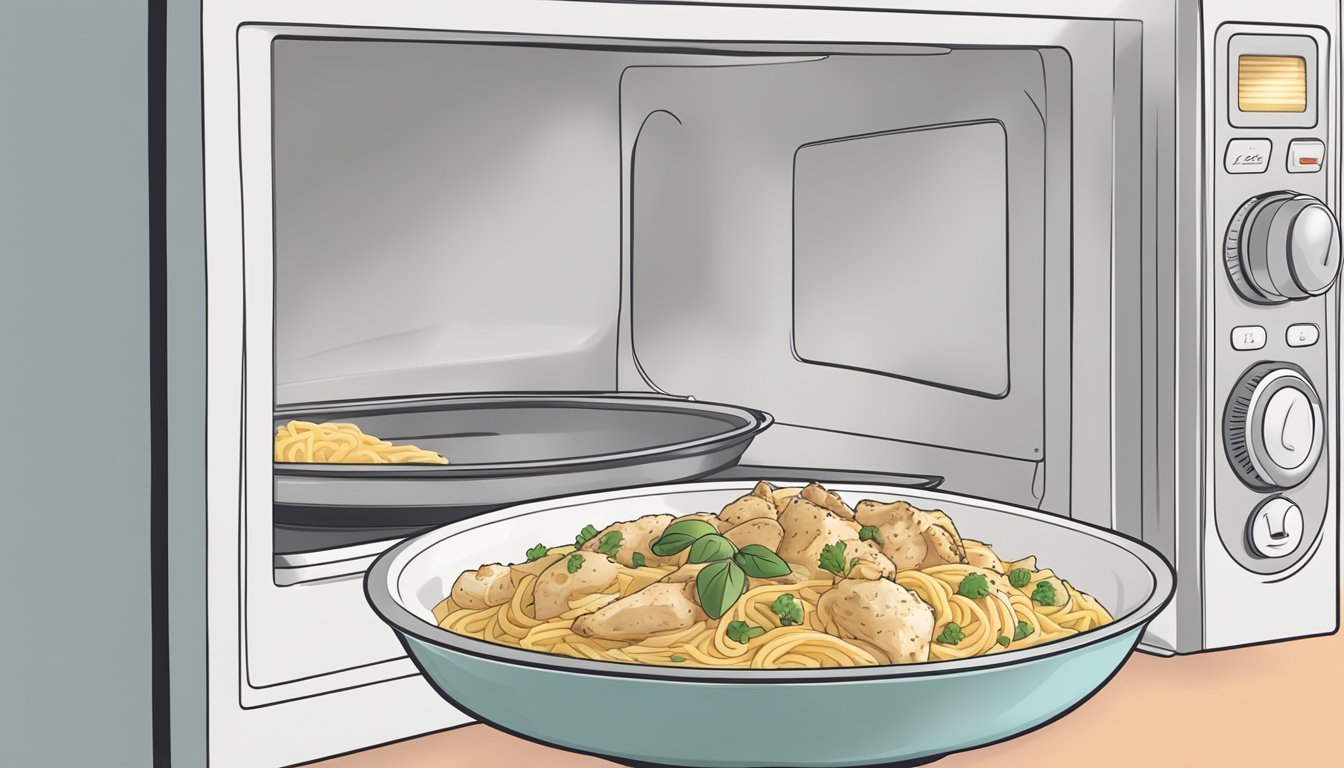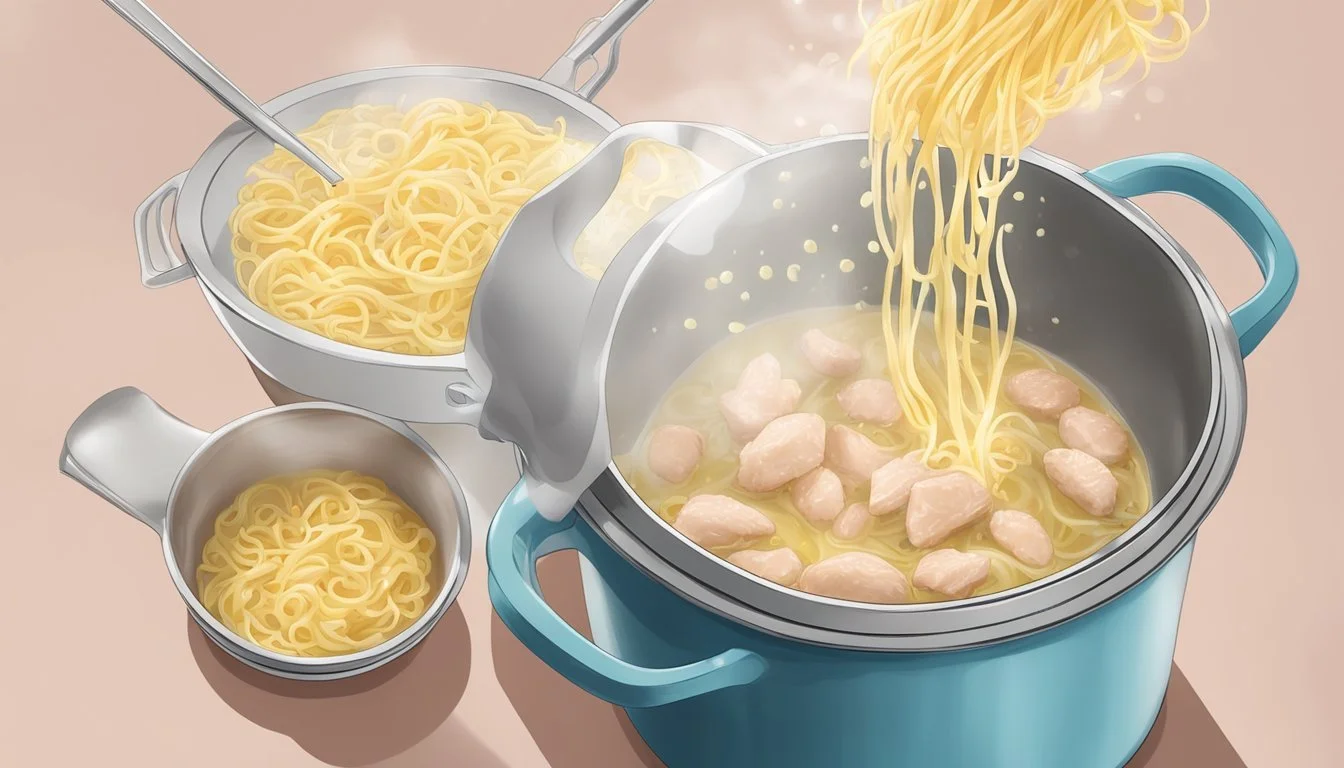How to Reheat Bertolli Chicken Carbonara
Simple Steps for Best Results
Reheating Bertolli Chicken Carbonara can be a challenge if you want to preserve its creamy texture and rich flavors. The best method to reheat this dish is to use a gentle heat source, such as a double boiler, ensuring the sauce doesn’t break and the chicken stays tender. This technique slowly warms up the carbonara, maintaining its consistency and taste.
Alternatively, using the stove with a splash of cream or broth helps to keep the pasta moist and prevents it from drying out. Stirring frequently ensures even heating throughout the dish. For those in a hurry, reheating in an oven works well, especially if covered with foil and a little additional liquid to lock in moisture.
No matter the method chosen, patience is key to achieving the best results. Each technique has its advantages, focusing on gentle and even heating to revive the flavors and texture of Bertolli Chicken Carbonara.
Understanding Carbonara
Carbonara is a classic Italian dish known for its creamy texture and distinct flavor. When reheating, preserving both the texture and flavor is crucial for an authentic experience.
Origin and Components of Carbonara
Carbonara originated in Rome, Italy, and has become a staple of Italian cuisine. The traditional ingredients include spaghetti, eggs, Pecorino Romano cheese, guanciale (Italian cured pork), and black pepper. These components combine to create a rich, comforting dish.
The simplicity of the ingredients is deceptive; achieving the perfect balance between the creamy sauce and the pasta requires skill. The eggs and cheese form a silky sauce that clings to each strand of spaghetti, while the guanciale adds a salty, savory depth. The black pepper provides a subtle but essential kick.
Importance of Preserving Texture and Flavor
Maintaining the creamy texture and distinct flavor of carbonara when reheating is essential. The sauce can dry out and become grainy if not reheated properly. Ensuring the sauce remains creamy and the pasta keeps its texture can make the difference between a delightful meal and a disappointing one.
Reheat carbonara gently and gradually. Use low heat to prevent the eggs from scrambling and the sauce from breaking. Adding a small amount of liquid such as water, milk, or cream can help maintain the sauce’s consistency. Gently stirring ensures an even heat distribution, keeping the pasta from clumping and the sauce from separating.
Balancing these elements allows for a reheated dish that closely matches the freshly made version, preserving the beloved attributes of traditional spaghetti carbonara.
Preparation for Reheating
To ensure the best texture and flavor when reheating Bertolli Chicken Carbonara, it is essential to properly prepare the leftovers. This involves bringing the carbonara to room temperature and carefully assessing its state before proceeding.
Bringing Carbonara to Room Temperature
Before reheating, take the leftover carbonara out of the refrigerator and let it sit at room temperature for about 15-20 minutes. This helps the pasta and sauce reheat evenly and reduces the risk of the sauce separating.
Place the carbonara in an airtight container if it isn't already in one. This step also minimizes exposure to air and prevents it from drying out. Letting the carbonara sit at room temperature ensures a more consistent reheating process.
Assessing the Carbonara's State
Examine the carbonara to determine its current state. Check if the pasta is clumped together or if the sauce has congealed. If the strands of pasta have stuck together, gently separate them using your hands or a fork.
If the sauce has thickened or become grainy, consider adding a small amount of cream, milk, or water to restore its creamy consistency. Any added liquid will help in achieving a smoother texture when reheating, making it more enjoyable to eat.
Taking these preparatory steps ensures that the reheated Bertolli Chicken Carbonara maintains its quality and taste.
Reheating Carbonara on the Stove
Reheating Bertolli Chicken Carbonara on the stove is effective for preserving its creamy texture and flavor. Utilizing a non-stick pan and maintaining a consistent low temperature are key to achieving the best results.
Using a Non-Stick Pan
A non-stick pan is essential for reheating Carbonara. It prevents sticking and ensures even heating. To start, add a small amount of olive oil or butter to the pan. Heat the pan on low to medium heat. Avoid high heat as it can cause the sauce to break and the pasta to overcook.
Once the oil or butter is hot, add the leftover Carbonara. Spread the pasta evenly in the pan. Use a spatula to gently separate any clumped strands of pasta. This helps the sauce coat the pasta evenly.
Maintaining Creamy Consistency
To maintain the creamy consistency, introduce a small amount of liquid. Water, milk, or cream can be used. Start with 1-2 tablespoons. This liquid helps rehydrate the pasta and keeps the sauce smooth.
Adding liquid gradually while stirring ensures it mixes well with the existing sauce. Keep the heat low to prevent the sauce from curdling.
Stirring is crucial to evenly distribute the heat and maintain the sauce's texture. Be careful not to add too much liquid at once as it can dilute the flavor.
Stirring to Avoid Lumps
Continuous stirring is essential while reheating on the stove. It prevents lumps and sticking. Use a wooden spoon or a heat-resistant spatula for best results.
Gently toss the pasta while stirring. This action helps the heat distribute evenly and prevents the sauce from separating.
If at any point the carbonara appears dry, add a bit more liquid. The key is consistency and patience. Continuous, gentle stirring ensures a smooth, creamy sauce without lumps or unevenly heated pasta.
This method guarantees a delicious reheated Bertolli Chicken Carbonara with a texture and flavor close to the original.
Reheating Carbonara in the Oven
When it comes to reheating Bertolli Chicken Carbonara in the oven, the key is maintaining the creamy texture. This can be achieved by using low heat and adding a bit of liquid.
Preheating and Container Preparation
Preheat the oven to 300°F (150°C). This temperature helps to gently warm the carbonara without drying it out. Use an oven-safe dish to reheat the carbonara. This dish should be large enough to spread the pasta in an even layer. Covering the dish with aluminum foil ensures the moisture is retained throughout the process.
Layering the Carbonara with Liquid
Spread the carbonara evenly in the preheated dish. To maintain its creamy consistency, add 1-2 tablespoons of liquid such as milk, water, stock, or olive oil. This prevents the pasta from becoming dry. Cover the dish with foil and place it in the oven. Bake for 5-7 minutes, stirring once halfway through to ensure even reheating. Continue until the carbonara is thoroughly heated.
Using the Microwave to Reheat Carbonara
Reheating carbonara in the microwave offers a quick and convenient way to enjoy your leftovers without compromising too much on taste or texture. Following specific steps can help minimize the risk of turning your pasta into a dry, clumpy mess.
Microwave-Safe Bowl and Plastic Wrap
Use a microwave-safe bowl large enough to hold your leftover pasta without spilling over. Place the carbonara in the bowl, spreading it evenly. Cover the bowl with a piece of plastic wrap, leaving a small gap to allow steam to escape. This helps trap moisture without creating excess pressure.
Alternatively, a damp paper towel can be placed over the bowl to keep the pasta from drying out. Both methods ensure the sauce remains creamy and the pasta heats evenly.
Reheating in Intervals
Set the microwave to medium power to avoid overheating. Start with an initial interval of 30 seconds. Stir the pasta to redistribute the heat and break up any clumps. Continue to heat in short bursts of 30 seconds, stirring in between, until the pasta is heated through.
This method prevents overheating specific sections and helps to maintain the carbonara's texture. Expect the process to take roughly 2-3 minutes in total, depending on the microwave's power and the amount of pasta.
Adding Moisture if Needed
If the pasta seems too dry after reheating, adding a bit of moisture can help. A splash of water or a dollop of cream can be mixed into the pasta before the final heating interval. This will help revive the sauce and restore its creamy consistency.
Another tip is to add a little olive oil or butter, which can enhance the flavor and texture of the reheated carbonara. Stir well to ensure the added moisture is evenly distributed. Each addition should be small to avoid making the pasta too watery.
By following these steps, you can enjoy a delicious and well-heated plate of carbonara with minimal effort.
Important Tips for Reheating Pasta Dishes
To safely and effectively reheat pasta dishes, particularly those with cream-based sauces such as Bertolli Chicken Carbonara, pay attention to preventing bacterial growth and follow best storage practices.
Preventing Bacterial Growth
Bacterial growth can be a concern with any cooked food, especially pasta dishes. Immediately after serving, refrigerate any leftovers in an airtight container within two hours. This helps to minimize the risk of bacteria multiplying.
When reheating, ensure that the pasta reaches an internal temperature of 165°F (74°C). Use a food thermometer to check. This temperature is sufficient to kill most bacteria. If using a microwave, heat the pasta in intervals, stirring in between to ensure even heating.
Avoid reheating leftovers more than once. Each reheating cycle increases the risk of bacterial contamination, so aim to consume reheated pasta immediately after warming.
Best Practices for Storage
Proper storage extends the life of your leftovers while maintaining safety. Store leftover carbonara in airtight containers to prevent moisture loss and prevent contamination. Glass containers with tight-fitting lids are ideal as they do not absorb odors.
Make sure to label containers with the date of storage. Leftovers can typically be refrigerated for 3 to 4 days. For longer storage, consider freezing the pasta dish. When doing so, separate the pasta from the sauce if possible, and store in separate containers. This will help maintain the quality and texture of both components.
When defrosting, always defrost in the refrigerator, not on the counter, to keep it out of the temperature danger zone. Reheat thoroughly before eating to enjoy your pasta dish safely and deliciously.
Serving Reheated Carbonara
When serving reheated Bertolli Chicken Carbonara, focus on retaining the creamy texture and enhancing the flavor with simple garnishments.
Garnishing for Freshness
Adding chopped parsley and grated parmesan can elevate the dish. Parsley brings a fresh, slightly peppery taste, offering a nice contrast to the rich sauce.
Use about a tablespoon of chopped parsley per serving.
Grated cheese like parmesan ensures the pasta dish has a robust, savory touch. Around a tablespoon of grated parmesan per serving balances the flavors.
For an al dente texture, ensure the pasta is not overcooked during reheating.
This can make the dish feel freshly made, even if it's being eaten the next day.
Conclusion
Reheating Bertolli Chicken Carbonara correctly ensures it remains as delicious as when freshly made. The process needs careful attention to preserve the creamy texture and prevent the pasta from drying out.
Using the stovetop method, gently heat a small amount of butter or oil in a pot. Add the carbonara pasta, then stir in some cream, broth, or water to maintain moisture. Constant stirring helps distribute heat evenly.
For oven reheating, preheat to 300°F (150°C). Spread the pasta evenly on a baking tray, add 1-2 tablespoons of liquid, and cover with foil. Heat for around 5-7 minutes, stirring once midway.
Microwave reheating can be quick but needs vigilance to avoid uneven heating. Place the pasta in a microwave-safe bowl, add a splash of liquid, and cover. Heat in short bursts, stirring thoroughly between intervals.
Key Points:
Use low to medium heat on the stovetop.
Stir frequently to avoid hot spots.
Add liquid to maintain creaminess.
Ensure even heating using the oven or microwave.
With these methods, Bertolli Chicken Carbonara will remain a delightful dinner option, delicious and creamy even after reheating. Following these steps attentively will help preserve its original taste and texture.






